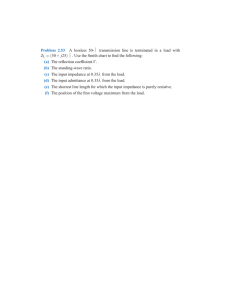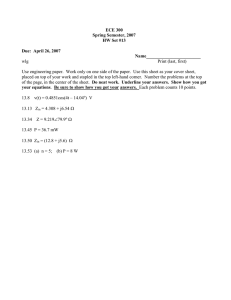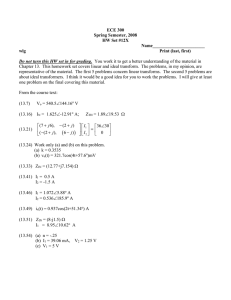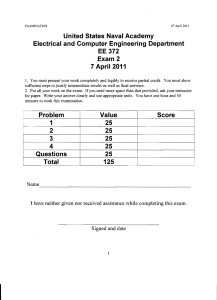Problem 2.20 A 300-Ω lossless air transmission line is connected to
advertisement
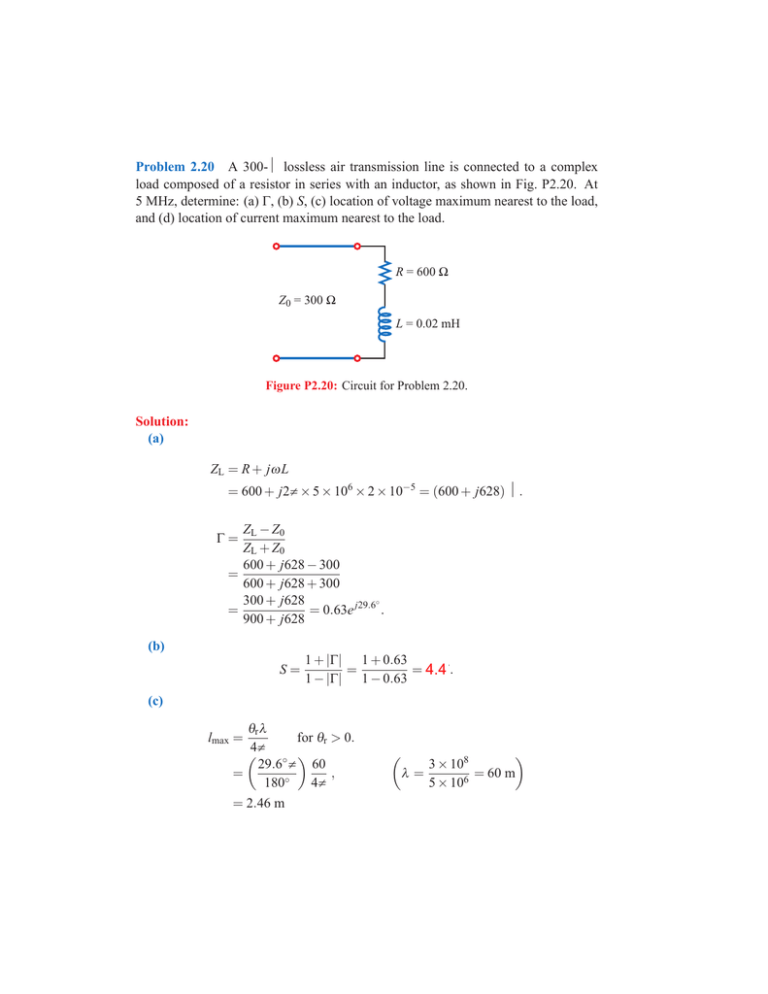
Problem 2.20 A 300-Ω lossless air transmission line is connected to a complex load composed of a resistor in series with an inductor, as shown in Fig. P2.20. At 5 MHz, determine: (a) Γ, (b) S, (c) location of voltage maximum nearest to the load, and (d) location of current maximum nearest to the load. R = 600 Ω Z0 = 300 Ω L = 0.02 mH Figure P2.20: Circuit for Problem 2.20. Solution: (a) ZL = R + j ω L = 600 + j2π × 5 × 106 × 2 × 10−5 = (600 + j628) Ω. ZL − Z 0 ZL + Z0 600 + j628 − 300 = 600 + j628 + 300 ◦ 300 + j628 = 0.63e j29.6 . = 900 + j628 Γ= (b) S= (c) 1 + |Γ| 1 + 0.63 = = 1.67. 4.4 1 − |Γ| 1 − 0.63 θr λ for θr > 0. 4 π µ ¶ 29.6◦ π 60 , = 180◦ 4π = 2.46 m lmax = µ ¶ 3 × 108 λ= = 60 m 5 × 106 (d) The locations of current maxima correspond to voltage minima and vice versa. Hence, the location of current maximum nearest the load is the same as location of voltage minimum nearest the load. Thus µ ¶ λ λ lmin = lmax + , lmax < = 15 m 4 4 = 2.46 + 15 = 17.46 m. Problem 2.30 Show that at the position where the magnitude of the voltage on the line is a maximum, the input impedance is purely real. Solution: From Eq. (2.70), dmax = (θr + 2nπ )/2β , so from Eq. (2.61), using polar representation for Γ, Ã ! 1 + |Γ|e jθr e− j2β lmax Zin (dmax ) = Z0 1 − |Γ|e jθr e− j2β lmax ! Ã ¶ µ 1 + |Γ| 1 + |Γ|e jθr e− j(θr +2nπ ) , = Z0 = Z0 1 − |Γ| 1 − |Γ|e jθr e− j(θr +2nπ ) which is real, provided Z0 is real. Problem 2.33 Two half-wave dipole antennas, each with an impedance of 75 Ω, are connected in parallel through a pair of transmission lines, and the combination is connected to a feed transmission line, as shown in Fig. P2.33. λ 0.2 0.3λ 75 Ω (Antenna) Zin1 Zin2 Zin 0.2 λ 75 Ω (Antenna) Figure P2.33: Circuit for Problem 2.33. All lines are 50 Ω and lossless. (a) Calculate Zin1 , the input impedance of the antenna-terminated line, at the parallel juncture. (b) Combine Zin1 and Zin2 in parallel to obtain ZL′ , the effective load impedance of the feedline. (c) Calculate Zin of the feedline. Solution: (a) Zin1 · ¸ ZL1 + jZ0 tan β l1 = Z0 Z0 + jZL1 tan β l1 ½ ¾ 75 + j50 tan[(2π /λ )(0.2λ )] = 50 = (35.20 − j8.62) Ω. 50 + j75 tan[(2π /λ )(0.2λ )] (b) ZL′ = (c) (35.20 − j8.62)2 Zin1 Zin2 = = (17.60 − j4.31) Ω. Zin1 + Zin2 2(35.20 − j8.62) l = 0.3 λ ZL' Zin Figure P2.33: (b) Equivalent circuit. ½ (17.60 − j4.31) + j50 tan[(2π /λ )(0.3λ )] Zin = 50 50 + j(17.60 − j4.31) tan[(2π /λ )(0.3λ )] ¾ = (107.57 − j56.7) Ω. Problem 2.50 Use the Smith chart to determine the input impedance Zin of the two-line configuration shown in Fig. P2.50. l1 = 3λ/8 C B Zin Z01 = 100 Ω l2 = 5λ/8 A Z02 = 50 Ω ZL = (75 − j50) Ω Figure P2.50: Circuit for Problem 2.50. Solution: 0.625 λ 1.0 1.4 4 0.1 1.6 7 0.3 3 0.1 1.8 0.6 60 0.5 50 2 0.4 0.2 40 0.3 3.0 0.6 1 0.2 9 0.2 30 4.0 1.0 0.28 1.0 5.0 0.2 20 8 0. 0.25 0.26 0.24 0.27 0.23 0.25 0.24 0.26 0.23 COEFFICIENT IN 0.27 REFLECTION DEGR LE OF EES ANG 0.6 10 0.1 0.4 20 0.2 10 5.0 4.0 3.0 2.0 1.8 1.6 1.4 1.2 0.9 0.8 0.7 0.6 0.5 0.4 1.0 50 0.3 50 50 4 0. 0.3 0.8 SWR Circle RESISTANCE COMPONENT (R/Zo), OR CONDUCTANCE COMPONENT (G/Yo) 0.2 20 0.4 0.1 10 0.6 Br A 8 -20 0. 1.0 5.0 0.47 1.0 4.0 0.8 9 0.6 3.0 2.0 1.8 0.2 1.6 -60 1.4 -70 0.15 0.35 1.2 6 4 0.14 -80 0.36 1.0 0.1 0.3 0.9 7 3 0.8 0.1 0.3 0.7 0.308 λ 2 0.6 8 0.1 0 -5 0.3 0.5 31 0. 0.1 0.4 1 -110 0.0 9 0.4 2 0.0 CA 1 P 8 A 2 0 CIT I V 0.4 ER EA 3 CT 0.0 AN 7 CE -1 30 CO M PO N EN T (-j 06 0.4 0. 0.3 19 0. 44 0.2 0.2 0 -4 4 0. 0.28 0.2 1 -30 0.3 -90 0.12 0.13 0.38 0.37 0.11 -100 0.433 λ 0.22 0.2 0. 0.22 0.0 —> WAVELEN 0.49 GTHS TOW ARD 0.48 — 0.0 0.49 GEN D LOAD < ERA OWAR 0.48 ± 180 HS T T TO G 170 N R— -170 ELE 0.47 V > WA 0.0 6 160 0 — 6 4 .4 < 0 -1 0.4 4 6 0.0 IND ) o UCT 0.0 /Y 5 15 0 (-jB I 5 5 V 0 E 1 0.4 ER C 0.4 EA AN 5 CT 5 PT 0.0 AN CE 0.1 CE US ES C V OM I 14 40 0 CT PO -1 DU N EN IN R T O (+ ), jX o Z /Z 0.2 X/ 8 0.3 2.0 0.2 20 0. 06 0. 44 6 0.3 31 0. R ,O o) 0 12 0.1 70 19 0. 3 0.4 0 13 0.35 80 Yo) jB/ E (+ NC TA EP SC U S VE TI CI PA CA 2 0.4 7 0.15 0.36 90 0.7 0.0 0.0 110 0.14 0.37 0.38 1.2 1 0.4 0.8 0.4 9 0.0 8 0.39 100 0.9 0.1 0.13 0.12 0.11 0.4 0.39 Smith Chart 1 Starting at point A, namely at the load, we normalize ZL with respect to Z02 : zL = 75 − j50 ZL = = 1.5 − j1. Z02 50 (point A on Smith chart 1) From point A on the Smith chart, we move on the SWR circle a distance of 5λ /8 to point Br , which is just to the right of point B (see figure). At Br , the normalized input impedance of line 2 is: zin2 = 0.48 − j0.36 (point Br on Smith chart) Next, we unnormalize zin2 : Zin2 = Z02 zin2 = 50 × (0.48 − j0.36) = (24 − j18) Ω. 1.2 1.0 1.4 0.7 0.1 1.6 7 0.3 3 0.1 1.8 0.6 60 8 0.3 0.5 2.0 0.2 2 50 0.4 0.3 3.0 0.6 1 0.2 9 4.0 0.28 1.0 5.0 0.2 20 8 0. 0.25 0.2 6 0.24 0.27 0.23 0.25 0.24 0.26 0.23 COEFFICIENT IN 0.27 REFLECTION DEGR LE OF EES ANG 0.6 10 0.1 0.4 20 0.2 10 5.0 4.0 3.0 2.0 1.8 1.6 1.4 1.2 0.9 0.8 0.7 0.6 0.5 0.4 1.0 50 0.3 50 RESISTANCE COMPONENT (R/Zo), OR CONDUCTANCE COMPONENT (G/Yo) 0.2 20 0.4 0.1 10 Bl 0.6 8 -20 0. 1.0 5.0 0.47 1.0 4.0 0.8 C 3.0 0.6 2.0 0.5 1.8 0.2 1.6 -60 1.4 -70 1.2 6 4 0.15 0.14 -80 0.35 0.36 1.0 0.1 0.3 0.9 7 3 0.7 0.1 0.3 0.8 8 2 0.6 0 0.1 0.3 0.1 0.4 1 -110 0.0 9 0 .4 2 CAP -12 0.08 AC 0 ITI V 0.4 E RE 3 AC 0.0 TA 7 NC -1 E 30 C OM PO N EN T (-j 06 0.4 31 0. -5 0. 0.3 19 0. 44 0.2 0 -4 4 0. 0.28 9 0.2 1 -30 0.2 0.3 0. 0.22 0.2 0.470 λ 0.22 1.0 50 4 0. 0.3 30 0.8 0.2 0.0 —> WAVELEN 0.49 GTHS TOW ARD 0.48 <— 0.0 0.49 GEN RD LOAD ERA TOWA 0.48 ± 180 THS TO G 17 0 N 0 R— -17 E 0.47 VEL > A W 0.0 6 160 4 <— 0.4 -160 0.4 4 6 0.0 IND o) Y U 0.0 / CTI 5 15 jB 0 5 VE 0 E (0.4 -15 C RE N 0.4 5 AC TA 5 TA 0.0 EP 0.1 NC SC U EC ES V O I 1 M 40 40 CT PO -1 DU N EN IN R T (+ ,O jX o) Z / 0.2 Z X/ 0.2 40 SWR Circle 20 06 0. 4 31 44 6 0.3 0. 0. 0.1 70 19 R ,O o) 0.375 λ 0.35 80 0. 3 0.4 0 13 0.15 0.36 90 Yo) 0 0 jB/ 12 E (+ NC TA EP C S SU VE TI CI PA CA .42 7 0.0 110 0.14 0.37 0.38 0.9 1 0.4 0.8 9 0.0 8 0.0 0.39 100 0.4 0.13 0.12 0.11 0.1 0.345 λ -90 0.12 0.13 0.38 0.37 0.11 -100 0.4 0.39 Smith Chart 2 To move along line 1, we need to normalize with respect to Z01 . We shall call this zL1 : zL1 = Zin2 24 − j18 = = 0.24 − j0.18 Z01 100 (point Bℓ on Smith chart 2) After drawing the SWR circle through point Bℓ , we move 3λ /8 towards the generator, ending up at point C on Smith chart 2. The normalized input impedance of line 1 is: zin = 0.66 − j1.25 which upon unnormalizing becomes: Zin = (66 − j125) Ω. Problem 2.53 A lossless 50-Ω transmission line is terminated in a load with ZL = (50 + j25) Ω. Use the Smith chart to find the following: (a) The reflection coefficient Γ. (b) The standing-wave ratio. (c) The input impedance at 0.35λ from the load. (d) The input admittance at 0.35λ from the load. (e) The shortest line length for which the input impedance is purely resistive. (f) The position of the first voltage maximum from the load. 1.0 0.9 0.35 0.1 6 70 0.3 4 1.4 0.1 7 1.6 ) 2 /Yo 0 0.4 12 (+jB CE AN PT CE S SU VE TI CI PA CA 60 0.1 0.4 0.106 λ 0.2 40 0.3 3.0 0.6 1 0.2 9 4.0 0.28 1.0 5.0 0.2 20 8 0. 0.25 0.26 0.24 0.27 0.23 0.25 0.24 0.26 0.23 COEFFICIENT IN 0.27 REFLECTION DEGR LE OF EES ANG 0.6 Z-LOAD 10 0.1 0.4 20 0.2 10 5.0 SWR 4.0 3.0 2.0 1.8 1.6 1.4 1.2 1.0 0.9 0.8 0.7 0.6 0.5 0.4 0.3 50 Z-IN 50 RESISTANCE COMPONENT (R/Zo), OR CONDUCTANCE COMPONENT (G/Yo) 0.2 20 0.4 0.1 10 0.6 8 -20 0. 1.0 0.47 5.0 1.0 4.0 0.8 9 0.6 3.0 2.0 1.8 0.2 1.6 -60 6 4 1.4 -70 0.15 0.35 1.2 0.1 0.3 0.14 -80 0.36 0.9 7 1.0 0.1 3 0.8 0.350 λ 0.3 0.7 2 0.6 8 0.1 0 -5 0.3 0.5 31 0. 0.1 0.4 1 -110 0.0 9 0.4 2 CAP -12 0.08 A 0 C ITI VE 0.4 RE 3 AC 0.0 TA 7 NC -1 EC 30 O M PO N EN T (-j 06 0.4 19 0. 0. 0.3 0 -4 44 0.2 4 0. 1 0.2 0.2 -30 0.3 0.28 0.22 0.2 0. 0.22 1.0 50 4 0. 0.3 30 0.8 0.2 0.0 —> WAVELEN 0.49 GTHS TOW ARD 0.48 <— 0.0 0.49 GEN RD LOAD ERA TOWA 0.48 ± 180 THS TO G 170 0 N R— -17 E 0.47 VEL > A W 0.0 6 160 4 <— 0.4 -160 0.4 4 .0 6 0 IND Yo) UCT 0.0 / 5 15 B j 0 (IVE 5 0 0.4 -15 CE R N 0.4 E 5 AC TA 5 TA 0.0 EP 0.1 NC SC SU EC E V OM 14 0 TI 4 0 C PO -1 DU N EN IN R T (+ ,O jX o) Z /Z 0.2 X/ 2 31 0. R ,O o) 50 19 0. 13 8 0.3 0.5 0 0.2 20 0 3 2.0 .43 0.3 1.8 0.6 7 0.0 0. 06 0.15 θr 0.7 0.0 0. 44 80 1.2 0 8 110 0.36 90 0.8 .41 0.14 0.37 0.38 0.39 100 0.4 0.13 0.12 0.11 0.1 9 0.0 -90 0.12 0.13 0.38 0.37 0.11 -100 0.4 0.39 Figure P2.53: Solution of Problem 2.53. Solution: Refer to Fig. P2.53. The normalized impedance zL = (50 + j25) Ω = 1 + j0.5 50 Ω is at point Z-LOAD. ◦ (a) Γ = 0.24e j76.0 The angle of the reflection coefficient is read of that scale at the point θr . (b) At the point SW R: S = 1.64. (c) Zin is 0.350λ from the load, which is at 0.144λ on the wavelengths to generator scale. So point Z-IN is at 0.144λ + 0.350λ = 0.494λ on the WTG scale. At point Z-IN: Zin = zin Z0 = (0.61 − j0.022) × 50 Ω = (30.5 − j1.09) Ω. (d) At the point on the SWR circle opposite Z-IN, Yin = yin (1.64 + j0.06) = = (32.7 + j1.17) mS. Z0 50 Ω (e) Traveling from the point Z-LOAD in the direction of the generator (clockwise), the SWR circle crosses the xL = 0 line first at the point SWR. To travel from Z-LOAD to SWR one must travel 0.250λ − 0.144λ = 0.106λ . (Readings are on the wavelengths to generator scale.) So the shortest line length would be 0.106λ . (f) The voltage max occurs at point SWR. From the previous part, this occurs at z = −0.106λ . Problem 2.68 A 50-Ω lossless line is to be matched to an antenna with ZL = (75 − j20) Ω using a shorted stub. Use the Smith chart to determine the stub length and distance between the antenna and stub. 1.0 1.2 1.4 1.6 7 3 0.1 1.8 0.6 0.3 0.2 2 0.4 0.2 40 0.3 3.0 0.6 1 0.2 9 4 0. 0.3 30 0.8 0.2 4.0 1.0 0.28 1.0 5.0 0.2 20 8 0. 0.25 0.26 0.24 0.27 0.23 0.25 0.24 0.26 0.23 COEFFICIENT IN 0.27 REFLECTION DEGR LE OF EES ANG Y-LOAD-IN-1 0.6 10 0.1 0.4 Y-LOAD 20 0.2 10 5.0 4.0 3.0 2.0 1.8 1.6 1.4 1.2 1.0 0.9 0.8 0.7 0.6 0.5 0.4 Y-SHT 50 0.3 50 RESISTANCE COMPONENT (R/Zo), OR CONDUCTANCE COMPONENT (G/Yo) 0.2 20 Z-LOAD 0.4 0.1 10 0.6 8 -20 0. 1.0 0.47 5.0 1.0 4.0 0.8 9 0.6 3.0 2.0 1.8 0.2 1.6 -60 1.4 -70 0.15 0.35 1.2 6 4 0.173 λ 0.14 -80 0.36 0.9 0.1 0.3 1.0 3 0.8 7 0.3 0.7 0.1 0.6 8 0.1 0 -5 2 Y-STUB-IN-1 0.3 0.5 31 0. 0.1 0.4 1 -110 0.0 9 0 .4 2 CAP -12 0.08 AC 0 I T IVE 0.4 RE 3 AC 0.0 TA 7 NC -1 EC 30 O M PO N EN T (-j 06 0.4 19 0. 0. 0.3 0 -4 44 0.2 4 0. 1 0.2 0.2 -30 0.3 0.28 0.22 0.2 0. 0.22 0.0 —> WAVELEN 0.49 GTHS TOW ARD 0.48 <— 0.0 0.49 GEN RD LOAD ERA TOWA 0.48 ± 180 THS TO G 170 0 N R— -17 E 0.47 VEL > A W 0.0 6 160 4 <— 0.4 -160 0.4 4 .0 6 0 IND Yo) UCT 0.0 / 5 15 B j 0 (IVE 5 0 0.4 -15 CE R N 0.4 E 5 AC TA 5 TA 0.0 EP 0.1 NC SC SU EC E V OM 14 0 TI 4 0 C PO -1 DU N EN IN R T (+ ,O jX o) Z /Z 0.2 X/ 8 0.3 50 50 0. 06 0.1 60 31 0. 0. 44 4 19 0. R ,O o) 6 0.3 20 0 13 0 12 0.1 70 2.0 0 0.35 80 0.5 .43 0.15 0.36 90 Yo) jB/ E (+ NC TA EP SC SU E V TI CI PA CA 2 0.4 0 110 0.14 0.37 0.38 0.7 0.0 .07 0.8 1 0.4 8 0.39 100 0.4 0.13 0.12 0.11 0.1 9 0.0 0.9 0.104 λ -90 0.12 0.13 0.38 0.37 0.11 -100 0.4 0.39 Figure P2.68: (a) First solution to Problem 2.68. Solution: Refer to Fig. P2.68(a) and Fig. P2.68(b), which represent two different solutions. ZL (75 − j20) Ω zL = = = 1.5 − j0.4 Z0 50 Ω and is located at point Z-LOAD in both figures. Since it is advantageous to work in admittance coordinates, yL is plotted as point Y -LOAD in both figures. Y -LOAD is at 0.041λ on the WTG scale. For the first solution in Fig. P2.68(a), point Y -LOAD-IN-1 represents the point at which g = 1 on the SWR circle of the load. Y -LOAD-IN-1 is at 0.145λ on the WTG scale, so the stub should be located at 0.145λ − 0.041λ = 0.104λ from the load (or some multiple of a half wavelength further). At Y -LOAD-IN-1, b = 0.52, so a stub with an input admittance of ystub = 0 − j0.52 is required. This point is Y -STUB-IN-1 and is at 0.423λ on the WTG scale. The short circuit admittance is denoted by point Y -SHT, located at 0.250λ . Therefore, the short stub must be 0.423λ − 0.250λ = 0.173λ long (or some multiple of a half wavelength longer). 1.0 0.9 1.2 1.6 7 3 0.1 1.8 0.6 0.5 2 50 0.4 0.314 λ 0.2 40 0.3 3.0 0.6 1 0.2 9 4.0 0.28 1.0 5.0 0.2 20 8 0. 0.25 0.26 0.24 0.27 0.23 0.25 0.24 0.26 0.23 COEFFICIENT IN 0.27 REFLECTION DEGR LE OF EES ANG 0.6 10 0.1 0.4 Y-LOAD 20 0.2 10 5.0 4.0 3.0 2.0 1.8 1.6 1.4 1.2 1.0 0.9 0.8 0.7 0.6 0.5 0.4 Y-SHT 50 0.3 50 RESISTANCE COMPONENT (R/Zo), OR CONDUCTANCE COMPONENT (G/Yo) 0.2 20 Z-LOAD 0.4 0.1 10 Y-LOAD-IN-2 0.6 8 -20 0. 1.0 0.47 5.0 1.0 4.0 0.8 9 0.6 3.0 2.0 1.8 0.2 1.6 -60 1.4 -70 0.15 0.35 1.2 6 4 0.14 -80 0.36 0.9 0.1 0.3 1.0 7 3 06 0.7 0.1 0.3 0.8 8 2 0.6 0 0.1 0.3 0.1 0.4 1 -110 0.0 9 0.4 2 0.0 CAP -1 8 A 2 0 C ITI VE 0.4 RE 3 AC 0.0 TA 7 NC -1 EC 30 O M PO N EN T (-j 0.5 31 0. -5 0. 0.4 9 0. 1 -90 0.12 0.13 0.38 0.37 0.11 -100 0.39 0.4 0.327 λ 0.3 0 -4 44 0.2 4 0. 1 0.2 0.2 -30 0.3 0.28 0.22 0.2 0. 0.22 1.0 50 4 0. 0.3 30 0.8 0.2 0.0 —> WAVELEN 0.49 GTHS TOW ARD 0.48 <— 0.0 0.49 GEN RD LOAD ERA TOWA 0.48 ± 180 THS TO G 170 0 N R— -17 E 0.47 VEL > A W 0.0 6 160 4 <— 0.4 -160 0.4 4 .0 6 0 IND Yo) UCT 0.0 / 5 15 B j 0 (IVE 5 0 0.4 -15 CE R N 0.4 E 5 AC TA 5 TA 0.0 EP 0.1 NC SC SU EC E V OM 14 0 TI 4 0 C PO -1 DU N EN IN R T (+ ,O jX o) Z /Z 0.2 X/ 8 0.3 2.0 Y-STUB-IN-2 0.3 20 06 0. 0.1 60 0.2 31 44 4 0. 0. 6 0.3 19 R ,O o) 0.1 70 0. 3 0.4 0 13 0.35 80 ) /Yo 0 0 12 (+jB CE AN PT CE S SU VE TI CI PA CA .42 7 0.15 0.36 90 1.4 0.0 0.0 110 0.14 0.37 0.38 0.7 8 0.8 0.4 9 0.0 1 0.4 0.39 100 0.13 0.12 0.11 0.1 Figure P2.68: (b) Second solution to Problem 2.68. For the second solution in Fig. P2.68(b), point Y -LOAD-IN-2 represents the point at which g = 1 on the SWR circle of the load. Y -LOAD-IN-2 is at 0.355λ on the WTG scale, so the stub should be located at 0.355λ − 0.041λ = 0.314λ from the load (or some multiple of a half wavelength further). At Y -LOAD-IN-2, b = −0.52, so a stub with an input admittance of ystub = 0 + j0.52 is required. This point is Y -STUB-IN-2 and is at 0.077λ on the WTG scale. The short circuit admittance is denoted by point Y -SHT, located at 0.250λ . Therefore, the short stub must be 0.077λ − 0.250λ + 0.500λ = 0.327λ long (or some multiple of a half wavelength longer). Problem 2.74 A 25-Ω antenna is connected to a 75-Ω lossless transmission line. Reflections back toward the generator can be eliminated by placing a shunt impedance Z at a distance l from the load (Fig. P2.74). Determine the values of Z and l. l=? B Z0 = 75 Ω A ZL = 25 Ω Z=? Figure P2.74: Circuit for Problem 2.74. Solution: 0.250 λ 1.0 1.2 1.6 7 0.1 1.8 0.6 3 2.0 0.5 2 0.2 40 0.3 3.0 0.6 1 9 0.8 0.2 30 SWR Circle 0.2 4.0 0.28 1.0 5.0 0.2 20 8 0. 0.25 0.26 0.24 0.27 0.23 0.25 0.24 0.26 0.23 COEFFICIENT IN 0.27 REFLECTION DEGR LE OF EES ANG 0.6 10 0.1 0.4 20 0.2 50 20 10 5.0 4.0 3.0 2.0 1.4 1.2 1.0 0.9 0.8 0.7 0.6 0.5 0.4 B 50 0.3 50 A 1.8 4 0. 0.3 1.0 RESISTANCE COMPONENT (R/Zo), OR CONDUCTANCE COMPONENT (G/Yo) 0.2 20 0.4 0.1 10 0.6 8 -20 0. 1.0 0.47 5.0 1.0 4.0 0.8 9 0.6 3.0 2.0 1.8 0.2 1.6 -60 4 1.4 -70 0.15 0.35 1.2 6 0.3 0.14 -80 0.36 0.9 0.1 1.0 7 3 0.7 0.1 0.3 0.8 8 2 0.6 0 0.1 0.3 0.1 0.4 1 -110 0.0 9 0.4 2 0.0 CAP -1 8 A 2 0 C ITI VE 0.4 RE 3 AC 0.0 TA 7 NC -1 EC 30 O M PO N EN T (-j 0.5 31 0. -5 -90 0.12 0.13 0.38 0.37 0.11 -100 0.39 0.4 06 0.4 9 0. 1 0. 0.3 0 -4 44 0.2 4 0. 0.2 0.2 1 -30 0.3 0.28 0.22 0.2 0. 0.22 0.0 —> WAVELEN 0.49 GTHS TOW ARD 0.48 — 0.0 0.49 GEN D LOAD < ERA OWAR 0.48 ± 180 HS T T TO G 170 0 R— -17 EN 0.47 VEL > A W 0.0 6 160 4 <— 0.4 -160 0.4 4 .0 6 0 IND o) Y U 0.0 / C 5 15 TIV 0 (-jB 5 0 0.4 ER -15 CE N 0.4 EA A 5 CT 5 PT 0.0 AN CE 0.1 CE US S CO VE 14 0 M TI 4 0 C PO -1 DU N EN IN R T O (+ ), jX o Z /Z 0.2 X/ 8 0.3 50 0.4 1.6 06 0. 44 0.1 0.3 60 0.2 31 0. 4 0. 0.500 λ 6 0.3 19 R ,O o) 0.1 70 0. 3 0.4 0 13 0.35 80 ) /Yo 0 0 12 (+jB CE AN PT CE S SU VE TI CI PA CA .42 7 0.15 0.36 90 1.4 0.0 0.0 110 0.14 0.37 0.38 0.7 8 0.8 0.4 9 0.0 1 0.4 0.39 100 0.9 0.1 0.13 0.12 0.11 0.750 λ The normalized load impedance is: zL = 25 = 0.33 75 (point A on Smith chart) The Smith chart shows A and the SWR circle. The goal is to have an equivalent impedance of 75 Ω to the left of B. That equivalent impedance is the parallel combination of Zin at B (to the right of the shunt impedance Z) and the shunt element Z. Since we need for this to be purely real, it’s best to choose l such that Zin is purely real, thereby choosing Z to be simply a resistor. Adding two resistors in parallel generates a sum smaller in magnitude than either one of them. So we need for Zin to be larger than Z0 , not smaller. On the Smith chart, that point is B, at a distance l = λ /4 from the load. At that point: zin = 3, which corresponds to yin = 0.33. Hence, we need y, the normalized admittance corresponding to the shunt impedance Z, to have a value that satisfies: yin + y = 1 y = 1 − yin = 1 − 0.33 = 0.66 1 1 z= = = 1.5 y 0.66 Z = 75 × 1.5 = 112.5 Ω. In summary, λ , 4 Z = 112.5 Ω. l=
